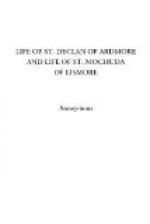As against the contradiction, anachronisms and extravagances of the Lives we have to put the fact that generally speaking the latter corroborate one another, and that they receive extern corroboration from the annals. Such disagreements as occur are only what one would expect to find in documents dealing with times so remote. To the credit side too must go the fact that references to Celtic geography and to local history are all as a rule accurate. Of continental geography and history however the writers of the Lives show much ignorance, but scarcely quite as much as the corresponding ignorance shown by Continental writers about Ireland.
The missionary methods of the early Irish Church and its monastic or semi-monastic system are frequently referred to as peculiar, if not unique. A missionary system more or less similar must however have prevailed generally in that age. What other system could have been nearly as successful amongst a pagan people circumstanced as the Irish were? The community system alone afforded the necessary mutual encouragement and protection to the missionaries. Each monastic station became a base of operations. The numerous diminutive dioceses, quasi-dioceses, or tribal churches, were little more than extensive parishes and the missionary bishops were little more in jurisdiction than glorified parish priests. The bishop’s ‘muintir,’ that is the members of his household, were his assistant clergy. Having converted the chieftain or head of the tribe the missionary had but to instruct and baptise the tribesmen and to erect churches for them. Land and materials for the church were provided by the Clan or the Clan’s head, and lands for support of the missioner or of the missionary community were allotted just as they had been previously allotted to the pagan priesthood; in fact there can be but little doubt that the lands of the pagan priests became in many cases the endowment of the Christian establishment. It is not necessary, by the way, to assume that the Church in Ireland as Patrick left it, was formally monastic. The clergy lived in community, it is true, but it was under a somewhat elastic rule, which was really rather a series of Christian and Religious counsels. A more formal monasticism had developed by the time of Mochuda; this was evidently influenced by the spread of St. Benedict’s Rule, as Patrick’s quasi-monasticism, nearly two centuries previously, had been influenced by Pachomius and St. Basil, through Lerins. The real peculiarity in Ireland was that when the community-missionary-system was no longer necessary it was not abandoned as in other lands but was rather developed and emphasised.




